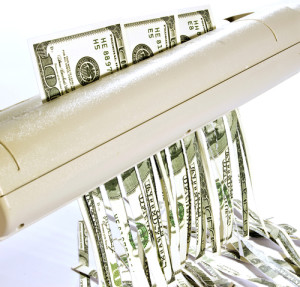 By Aman Raina, Sage Investors
By Aman Raina, Sage Investors
Special to the Financial Independence Hub
In the 20-plus years I have been investing, I have yet to meet or work with anyone who enjoys losing money.
I’ve met people who have lost money (yours truly included) and I can’t say it gives anyone or myself great satisfaction. We spend all of our time trying to make investment decisions that will be successful.
Unfortunately and it’s nobody’s fault, we don’t spend enough time understanding what losses mean and how they can impact our future decision making beyond the tangible reduction in our RRSP or TFSA broker account.
In my previous post, I discussed a concept involving the Endownment Effect that Richard Thaler observed in his book, Misbehaving: The making of behaviorial economics. According to Mr. Thaler, the Endowment Effect feeds into a general discussion on how we behave when it comes to losing and making money. Conventional thinking suggest that because we don’t like losing money that we will tend to take less risk to minimize loss and conversely take more risk when we are making money.
Losses “hurt” more than “gains” provide pleasure
Mr. Thaler argues in his research that we behave the opposite. When we lose money, we are more likely to make more riskier investment decisions and when we are making money we are more likely to make less riskier decisions. Mr. Thaler arugues essentially that losses hurt us more emotionally than gains and it can have a profound impact on our future decision making.
Mr. Thaler described this behavior wherein a loss hurts more than an equivalent gain gives pleasure as Loss Aversion. Mr. Thaler believes, “It has become the single most powerful tool in the behavioural economists arsenal.” Below is a graphical representation of this premise.
In Thaler’s research he noticed that the loss function is steeper than the gain function. It decreases more quickly than the gain function increases. Thaler observed that loses hurt twice as much as gains make you feel good.
Mr. Thaler observed that, “When we experience life in terms of changes, we feel diminishing sensitivity to both gains and losses and loses sting more than equivalently-sized gains feel good.“
Loss aversion implies people will be risk averse for gains but risk seeking for losses. If people are losing money they are more willing to take more risk to get back to break-even than in a case where if they were sure to get something. In that “sure thing” case, they were willing to take less risk. This concept is similar to the analogy you will hear in investing about “catching a falling knife.”
Try this experiment
The main reason why people are risk seeking for losses is the same logic that applies to when they are risk averse for gains. Mr. Thaler cites an experiment where he asked people to choose the following:
Assume you are richer by $300 than you are today and you are offered a choice of :
A: A sure gain of $100
B: A 50% chance to gain $200 and a 50% change of losing $0
72% of respondents chose A and 28% chose B.
He then asked people to assume they are richer by $500 than you are today and you are offered a choice of:
A: A sure loss of $100
B: A 50% chance of losing $200 and 50% chance of losing $0
In this case 64% chose B while 36% chose A
Thaler observed that the pain of potentially losing a second $100 or potentially breaking even in B is less than the guaranteed pain of losing the first $100 so people are ready to take the risk of losing more in order to have a chance to get back to even. People are very motivated to eliminate a loss at any cost.
Thaler also observed this concept in race track betting. He observed that a typical race track takes 17% of a bet so a bettor is essentially down 17% in each race before starting. When the last race of the day comes, most bettors who are in the red (tangibly and mentally when you factor the surcharge) will be willing to take more risk to get even and consequently bet on the longshot. But studies shows that the odds of longshots get worse on the last race of a day, meaning people are betting on horses least likely to win and will end up losing most of the money they started betting with.
From an investment perspective, Thaler also observed:
“Gambling when behind in an effort to break-even can also be seen in the behavior of pro investors. Mutual fund managers take more risk in the last quarter of a year a when fund is trailing benchmark. And much worse, rogue traders were taking huge risks when they were losing billions and putting company on verge of collapse in desperate attempts to break even. This behavior may have been rational for a rogue trader as they stood to lose their job.”
“[A] good rule is that people who have been threatened with big losses and have a chance to break even will be unusually willing to take risks even if they are normally risk averse. Watch out!”
I was recently tempted by this loss-aversion behaviour. I had owned a position in NeuLion, a company that implements streaming technology for sports leagues. The stock almost doubled for me on paper and I was keen on letting it ride as a personal test to get myself to own stocks for longer periods.
It was so far so good until one day the company lost a major contract and the stock fell by almost ½ in one day. Even though I was still up 25 per cent and the stock had been down 30 per cent at that moment on that fateful day, the thought crossed my mind to buy more stock. However, I had been reading Thaler’s book at the time and this concept of Loss Aversion and I realized that if I actually followed through and decided to buy more stock, I would be feeding into this behaviour.
So I decided to sell ¾ of my position and refrained from buying any stock. It turned out the stock fell another 20 per cent on that day, so I managed to preserve a small gain. I remember though, that feeling of losing a lot of money, even if it was just on paper, was very unsettling. In the past, my instinct would have been to hold on to the stock and most likely buy more stock to lower my average (i.e. catching the falling knife).
Averaging down
I will be honest. I do engage in Loss Aversion behaviour quite frequently. As my investing experience has evolved, I do buy more stock in a position that I am losing in order to lower my average cost base. What’s key is I don’t do it automatically anytime I am losing money on a stock. I always do my due diligence to review the fundamentals of the business and if they are still intact and they are still creating tangible wealth, have a clean balance sheet and are still selling at a discount, then I will likely add more stock to my position.
Thaler’s insights reinforce an overall theme that I believe in and which I try to instill with my coaching clients, which is that it’s just as important to manage your losses as it is to manage your gains. If you let your losses pile up, you will feed into Thaler’s loss aversion behaviour. which would encourage you to double down to get your money back, which clearly is the worst thing you can do.
Instead it’s more productive to set a consistent exit point where you would sell a stock if the loss threshold crossed a certain level. Instilling that discipline will preserve more of your capital in the long run and cap your losses. Developing this competency takes time but by working with an investment coach, this discipline can be developed.
 Aman Raina, MBA is an Investment Coach and founder of Sage Investors, an independent practice specializing in investment coaching and portfolio analysis services. This blog was originally published on his web site and is reproduced here with permission.
Aman Raina, MBA is an Investment Coach and founder of Sage Investors, an independent practice specializing in investment coaching and portfolio analysis services. This blog was originally published on his web site and is reproduced here with permission.


